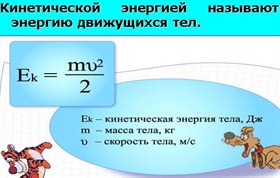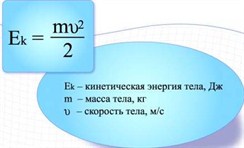ENERGY. KINETIC ENERGY
The purpose of the lesson: students should know the concept of energy, kinetic energy and its units of measurement.
Lesson type: combined.
Plan for learning new material.
1. The concept of the kinetic energy of the body and its unit of measurement.
2. Theorem on kinetic energy.
3. Calculation of the stopping distance of the car.
During the classes
I . Org. moment
Questioning absentees, checking homework.
II . Study of new material.
Energy
1. The concept of energy
If a body or system of bodies can do work, then they are said to have energy.
Energy in mechanics is a quantity determined by the state of the system - the position of bodies and their velocities; the measurement of energy during the transition of a system from one state to another is equal to the work of external forces.
1. The concept of the kinetic energy of the body and its unit of measurement.
Kinetic energy bodies - a scalar physical quantity equal to half the product of the body's mass and the square of its speed:
.Kinetic energy, like work, is measured in joules (J). Kinetic energy depends on the speed of the body, therefore its value depends on the choice of reference frame.
2. Theorem on kinetic energy.
Let us define a physical quantity that changes when work is done. Consider for this the motion of a body with mass t, whose speed increases with the speed
before and under the influence of all forces applied to it. The work of the resultant constant force coinciding in direction with the displacement is equal to BUT = F ∆ x . As F = ta,, then . OrThis formula is called the kinetic energy theorem, where
is the kinetic energy in initial moment time.The change in the kinetic energy of the body is equal to the work of all forces acting on the body: E to -E k0 =A. The kinetic energy theorem reduces to the equality
3. Calculation of the stopping distance of the car.
In the case of deceleration of a body with initial kinetic energy E k0
, until the stop ( v= 0, 0), the kinetic energy theorem should be represented asLet's find braking distances a car is the distance traveled by it until it comes to a complete stop. In the process of braking, the force of gravity, the reaction force of the support and the force of friction act on the car. The force of gravity and the reaction force of the support are directed perpendicular to the movement of the car, so their work is zero. This means that the total work of all forces is equal to the work of the sliding friction force. Considering that the force is directed opposite to the displacement l and what F tr =µ N , find BUT = BUT tr = - µ mgl
Topic 2. Energy and energy resources
A person constantly encounters the concept of energy and sometimes does not think about it. deep sense. Energy is defined as a general quantitative measure various forms the motion of matter. In accordance with the variety of forms of movement and distinguish between mechanical, thermal, electrical, nuclear, chemical and other types of energy.
In accordance with the conservation law discovered by M.V. Lomonosov, energy is not lost, but stored and converted into other types of energy.
Therefore, energy is the core that binds together all processes and phenomena. material world. For energy facilities, energy analysis is the main tool for studying energy conversion processes with verification at each stage. technological process fulfillment of the energy balance condition. In the process of transformation, part of the energy can change its form, which often complicates quantitative accounting and balance checks.
It was the needs of energy measurements at the dawn of the development of electrical engineering that stimulated active discussion at international exhibitions 1851 in London and 1855 in Paris the need to introduce unified system measures and weights. At the I International Congress of Electricians, held in 1881, a project was proposed complete system CGS units, which were based on the centimeter as a unit of length, the gram as a unit of mass and the second as a unit of time. But the use of this system in engineering calculations created certain difficulties due to the smallness basic units. In 1918 in France, and in 1927 in the USSR, the MTS system of units was adopted based on the meter, ton and second. However, it turned out to be uncomfortable, but already because of the other extreme.
In October 1960, the XI General Conference on Weights and Measures approved the draft of a unified system of units, on which a special commission had been working since 1954. This system became known as the International System of Units (SI). In 1961, the USSR approved GOST 9867-61 "International System of Units", which established the preferred use of SI units in all areas of science, technology, education and the national economy.
The basic SI units are the following seven units: length - meter, mass - kilogram, time - second, force electric current- ampere, temperature - kelvin, amount of substance - mole, luminous intensity - candela.
In addition to the basic units, the SI introduces big number derived quantities determined by branches of science and technology. Below in table. 3 shows the derived SI units that are used in electrical engineering.
Thus, despite the variety of types of energy, they are all measured in joules. For mechanical work, for example, one joule is determined by the work done by a unit of force on a path of one meter, i.e. 1J=1N 1m.
SI derived units Table 3
Opening law conservation of momentum, which states that the vector sum of the momenta of all bodies (or particles) closed system is a constant value, showed that the mechanical motion of bodies has a quantitative measure that is preserved during any interactions of bodies. This measure is momentum. However, only with the help of this law will not be able to give full explanation all laws of motion and interaction of bodies.
Consider an example. A 9 gram bullet at rest is absolutely harmless. But during the shot, when in contact with an obstacle, the bullet deforms it. It is obvious that such destructive effect is obtained as a result of the fact that the bullet has a special energy.
Let's consider another example. Two identical plasticine balls move towards each other with the same speed. When they collide, they stop and merge into one body.
The sum of the momenta of the balls before the collision and after the collision is the same and equal to zero, the momentum conservation law is satisfied. What happens to plasticine balls when they collide, except for a change in the speed of movement? The balls deform and heat up.
An increase in the temperature of bodies during a collision can be observed, for example, when a hammer strikes a lead or copper rod. A change in body temperature indicates changes in the rates of chaotic thermal motion atoms that make up the body. Consequently, mechanical motion did not disappear without a trace, it turned into another form of motion of matter.
Let's go back to the question we posed above. Is there a measure of the motion of matter in nature that is preserved during any transformations of one form of motion into another? Experiments and observations have shown that such a measure of motion exists in nature. They called it energy.
energy called physical quantity, which is a quantitative measure of various forms of motion of matter.
For exact definition energy as a physical quantity, it is necessary to find its relationship with other quantities, choose a unit of measurement and find ways to measure it.
 mechanical energy a physical quantity is called, which is a quantitative measure mechanical movement.
mechanical energy a physical quantity is called, which is a quantitative measure mechanical movement.
In physics, as such a quantitative measure of translational mechanical motion, when it arises from other forms of motion or is transformed into other forms of motion, a value equal to half the product of the mass of the body and the square of the speed of its motion is accepted. This physical quantity is called kinetic energy of the body and is marked with the letter E with index to:
E k \u003d mv 2 / 2
Since speed is a quantity that depends on the choice of frame of reference, the value of the kinetic energy of a body depends on the choice of frame of reference.
There is a theorem about kinetic energy. "The work of the resultant force applied to the body is equal to the change in its kinetic energy":
A \u003d E k2 -E k1
 This theorem will be valid both when the body moves under the action of a constant force, and when the body moves under the action of a changing force, the direction of which does not coincide with the direction of movement. Kinetic energy is the energy of motion. It turns out, kinetic energy of the body mass m moving at a speed v is equal to the work that the force applied to a body at rest must do to give it this speed:
This theorem will be valid both when the body moves under the action of a constant force, and when the body moves under the action of a changing force, the direction of which does not coincide with the direction of movement. Kinetic energy is the energy of motion. It turns out, kinetic energy of the body mass m moving at a speed v is equal to the work that the force applied to a body at rest must do to give it this speed:
A \u003d mv 2 / 2 \u003d E to
If the body moves with a speed v, then to stop it completely, work must be done:
A \u003d -mv 2 / 2 \u003d -E to
per unit of work in international system accept work done by force 1 Newton on a way 1 meter when moving in the direction of the force vector. This unit of work is called Joule.
1 J \u003d 1 kg m 2 / s 2
Since work equals change in energy, energy is measured in the same unit as work. Unit of energy in SI - 1J.
Do you have any questions? Do you know what kinetic energy is?
To get the help of a tutor - register.
The first lesson is free!
www.site, with full or partial copying of the material, a link to the source is required.
